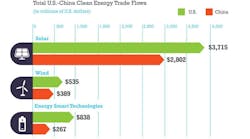The United States and China traded more than $8.5 billion worth of clean energy goods and services in 2011, the latest year for which data are available. According to a report released today by The Pew Charitable Trusts, U.S. companies enjoyed a $1.63 billion sales advantage over their Chinese counterparts.
The report, "Advantage America: The U.S.-China Clean Energy Trade Relationship in 2011," concludes that America's clean energy trade strength is derived from leadership in innovation and entrepreneurship, as well as the global presence of U.S. companies. China's clean energy industry has an advantage in large-scale manufacturing and high-volume assembly of certain clean energy products. However, tensions have been heightened in recent years by fiercely competitive market conditions affecting companies in both countries, as well as several high-profile trade cases.
"The report findings underscore the long-term economic potential for U.S. leadership in the clean energy sector," said Phyllis Cuttino, director of Pew's clean energy program. "Advantage America demonstrates the payoff for our leadership in wind, solar, and energy smart technology innovation. U.S. companies are tapping into the growing worldwide demand for clean energy goods and services. But, to maintain our competitive edge, it is essential that policymakers recognize and enhance domestic policies that help position U.S. companies for success -- investing in research and development, encouraging domestic demand and supporting overseas sales."
Among the report's major findings:
Solar Energy -- These products constituted the largest component of clean energy trade for both countries. Combined, firms based in the two nations traded more than $6.5 billion worth of products and services in 2011. Chinese firms sell large quantities of finished solar cells and modules to the U.S., which led in sales of high value-added goods and services, such as polysilicon and wafers, as well as the high-tech materials and equipment needed in solar manufacturing. On a net basis, the U.S. enjoyed a $913 million surplus in the solar sector. Solar accounted for 56% of the overall trade advantage held by the U.S.
Wind Energy -- This was the smallest of the three clean energy trade sectors examined in the report. Overall, more than $923 million worth of wind energy goods and services were exchanged between the two countries in 2011. As with solar, the U.S. wind industry excels in sales of relatively high-margin specialty materials (fiberglass) and sensitive electronic and other control systems. China's largest sales were in turbine towers and rotors. Overall, U.S. firms held a net trade surplus of just over $146 million.
Energy Smart Technologies -- This sector includes a suite of technologies, services and products that can help improve energy performance and/or efficiency, store energy, and reduce carbon emissions. Energy smart technologies traded between the United States and China include smart meters, light emitting diodes (LEDs), advanced lithium-ion batteries, and electric vehicles. More than $1.1 billion worth of these products flowed between the two countries, with the U.S. holding a net trade surplus of $571 million in the sector.
The report found U.S. companies are more active overseas than their Chinese counterparts,which have only small U.S. assembly operations for clean energy equipment. The U.S. trade advantage over Chinaincreased by more than $1.1 billion(to a total of $1.63 billion) when the global footprints of U.S. firms manufacturing products overseas were taken into account.



